

|
Home Updates Hydros Cars Engines Contacts Links Contact On The Wire |
Empty Spaces
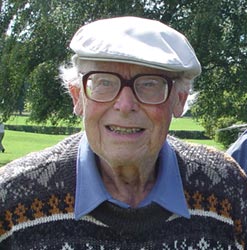
With the death of John, we have lost the last link with tethered hydroplane racing from the 1930s. It is amazing to consider that he started in model boating almost exactly eighty years ago and was active through to the end of the 2014 season, a record that is unlikely to be equalled. It was always a delight to talk to John as he was able to provide us with details of boats and personalities that were impossible to ascertain elsewhere. Although the legacy of a knee injury sustained many years ago eventually prevented him from getting into the water he still took an active part in the running of his Orthon 30cc boat and was still working on a new engine until quite recently. For a period of ten years or so he was the driving force behind the re-formed MPBA and provided most of the hydroplane related material in Model Engineer. His knowledge of the post war era, especially relating to Blackheath was encyclopaedic, and if there were any names he was unsure of, Joan was sure to come up with them, usually embellished with personal insights that never made it into print at the time.
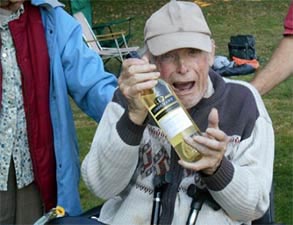 |
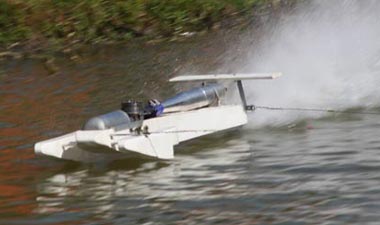 |
John's last regatta. Rowden Lake September 2014
The loss of John Benson will be felt throughout the model boating community as where we are now owes so much to what he did in the past and our condolences go the the Benson family. It would be an invidious task to try and detail John's exceedingly long and successful career with tethered hydros and straight runners so we feel that it is appropriate that this should be done via an article that he prepared for us for the centenary year in 2008.
John Benson on his long career
|
|
My interest in model power boats started while still at school. My cousin George had been a subscriber to “Model Engineer” from 1924 onwards to which I also had access and I read the articles on racing hydroplanes and regattas and decided that I would like to do this as hobby. When I came to live in the Blackheath area about 1934 George was planning a model power boat and gave much support to my early efforts. The house in Hyde Vale, Greenwich, was only about a mile from the Princess of Wales pond and power boats were to be seen in action every Sunday morning and often on weekday evenings as well. I soon found that the Blackheath Club was dormant and affiliation to the M.P.B.A. had lapsed. Joe Jepson the former Club Captain was still active and I gathered that the present situation was due to the resignation of the Hon. Secretary. After discussions over a fairly long period I agreed to do this job if Joe would be Chairman. Late in 1937 we sent a new list of members to the M.P.B.A. for affiliation. Alan Rayman was on this list so that he and I have equal time as members, now over 70 years. |
With the resumption of official activities in 1946, E.T. Westbury stated at a committee meeting that he would like to retire soon and at the 1948 A.G.M. I was made Hon. Secretary with Alan as Assistant. Alan was a tower of strength and among other things ran Club Championship for several years, publishing the results each year in the “Model Engineer”.
My service continued –1948 Hon. Secretary—1958 Hon. Competition Sec. and Treasurer—later Hon. Treasurer only until retirement in 1980.
My first hydroplanes were constructed about 1938 and strongly influenced by Joe Jepson who was a flash steam enthusiast. Two boats were built but neither of these were successful the chief problem being the cooling of the flash boiler due to erratic blowlamp performance.
|
A later boat “Erg” was built mainly during the war and was demonstrated at two early post-war M.E. Exhibitions in the circular tank. This tank or trough was only about 3 feet in width and perhaps 25 feet in diameter, also incorporating a track for model cars. The boat was run at about 20 mph and at this speed appeared quite spectacular threatening to jump out at any moment – one spectator actually offered to buy the boat on the spot. Right: 'Erg' on the line. |
|
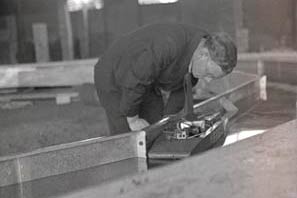 |
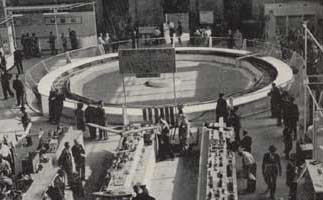 |
 |
| Testing out the tank with 'Erg' | The Grand Circular Track at the ME 1947. | 1940's at Bournville, John 2nd from left. |
|
My first successful I.C. engined hydroplane was “Moth” gaining the Wico-Pacy Trophy in 1948 (Moth II followed in 1951.) and the “Orthon” series of 30 cc Class A boats were very successful winning the International Speed Trophy several times in successive years in the mid 1950s. The best speed of 73.3mph was made at the French International at Le Visenet in 1953. Right: Brought
out of retirement after 40 years for a run at the MPBA 70th |
|
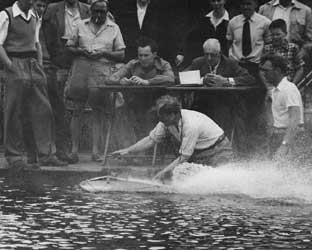 |
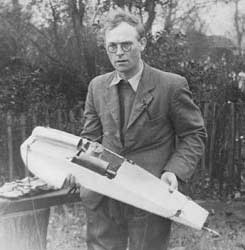 |
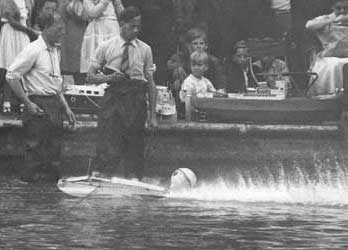 |
I was appointed as lecturer in engineering at Cambridge College of Arts and Technology in Sept. 1957 and this made hydroplane development more difficult due to the absence of any suitable water to operate the circular course since testing had to be done at Regattas during the run.
|
|
Work with flash steam boats continued intermittently with some good runs on occasions, but had to wait until 1975 before attaining the Crebbin Trophy for flash steamers at the Grand Regatta that year. |
Thanks to the support of my family I still manage to attend a few hydroplane meetings each year and at present am building a new 30 cc engine of the Schnuerle ported type.
 |
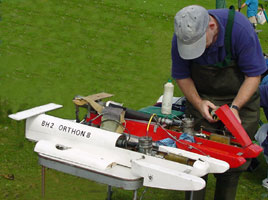 |
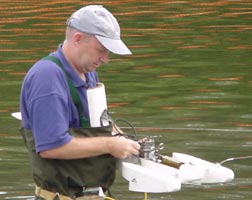 |
| John and his son Rick. | Rick prepares his own and John's boat. | Orthon goes on line. |
Talking to John is always a pleasure and rewarding, with additional pieces of information forthcoming which are added here.
|
|
Joe Jepson and William Blaney were John's mentors and along with the Blackheath Club ensured that there were always people around to nurture and channel his enthusiasm. John's straight runner featured in the report of the Brockwell Park Regatta in 1938, as that spectacular steamer 'Comet' and was to appear regularly round the regattas from then on. Left: John with Comet in 1939. Right: In 1947 |
|
|
John spent the war working under the official secrets act on naval radar at Plessey Co Ltd, he like many of the young men working there also joined the Home Guard. After the war John worked for an optical instrument maker near High Holborn moving on from there to the Medical Research Council (i/c research workshop) before finally becoming a lecturer. In 1949 John and 'Comet' achieved the elusive '3 bulls' for the first time which was also the first occasion that this had been managed at the POW Pond. |
||
|
|
John also wrote about the Club, with an article 'Blackheath carries on' which appeared in the 1941 March issue of the ME. Blackheath did indeed carry on and the Club has now celebrated 70 years. Front row John, Alan Rayman and Phil Abbot whose father, Ralph and grandfather, Cecil have also been stalwarts of the Blackheath Club. |
|
From 1951 John regularly wrote regatta reports, news and technical articles on the model powerboat scene under the non de plume 'Meridian', which continued to appear in the Model Engineer for several years. John also found time to co-write a book with his friend Alan Rayman entitled 'Experimental Flash Steam' which was first published in 1973. |
|
|
|
At the St. Albans meeting in 2008, John seen here with his wife Joan, was presented with the MPBA long service award by Sue Free in recognition of 70 years service to the Association. In September they both travelled up to the Rowden Regatta to join other enthusiast's from around the country celebrating 100 years of tethered hydroplane racing. At 92 years, John was most senior active competitor to attend this meeting. |
Many thanks to John Benson for text and photo's, and to Phil Abbot and the Westbury family for additional photo's.
©copyrightJohnBenson&OTW2008.